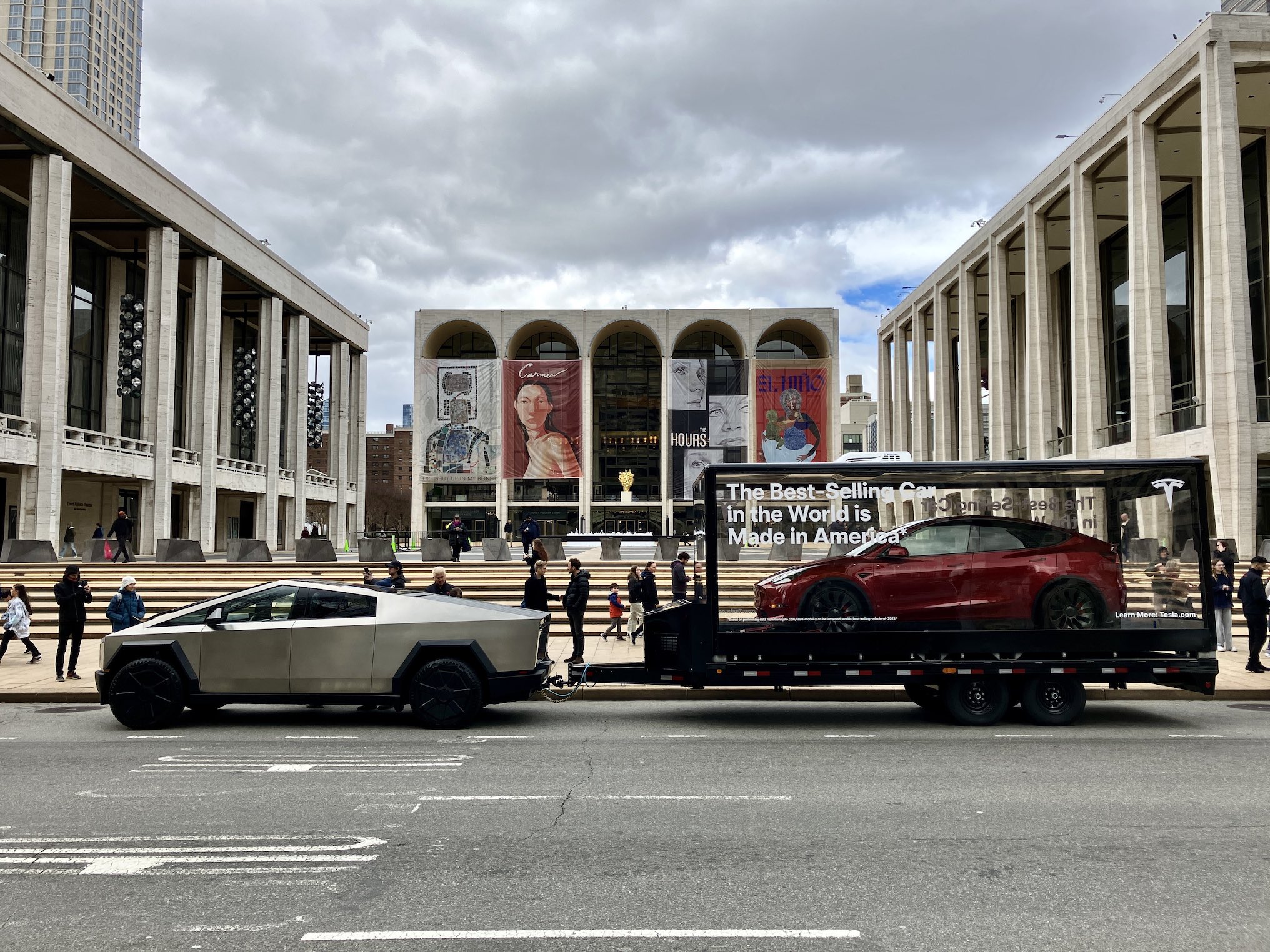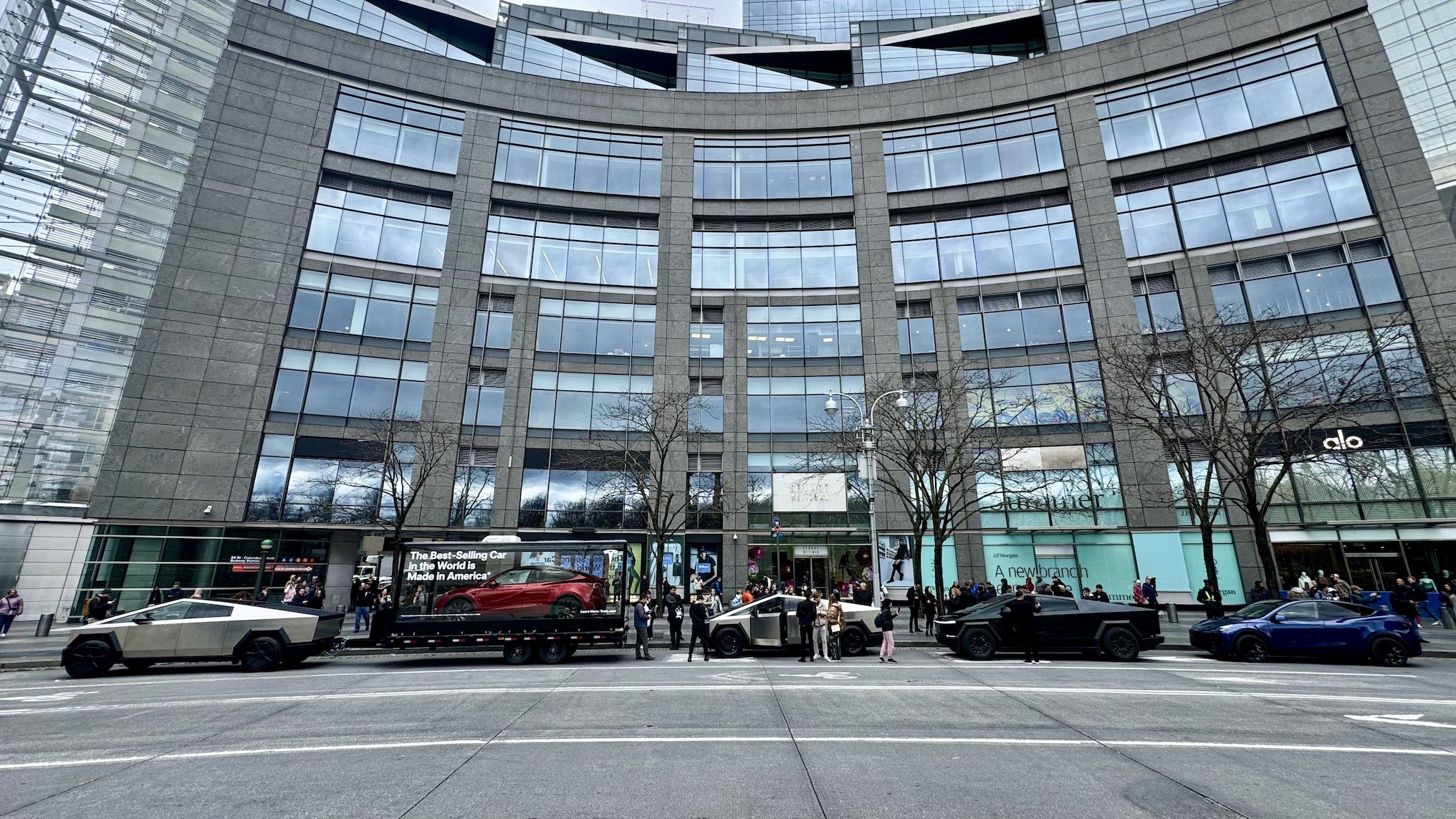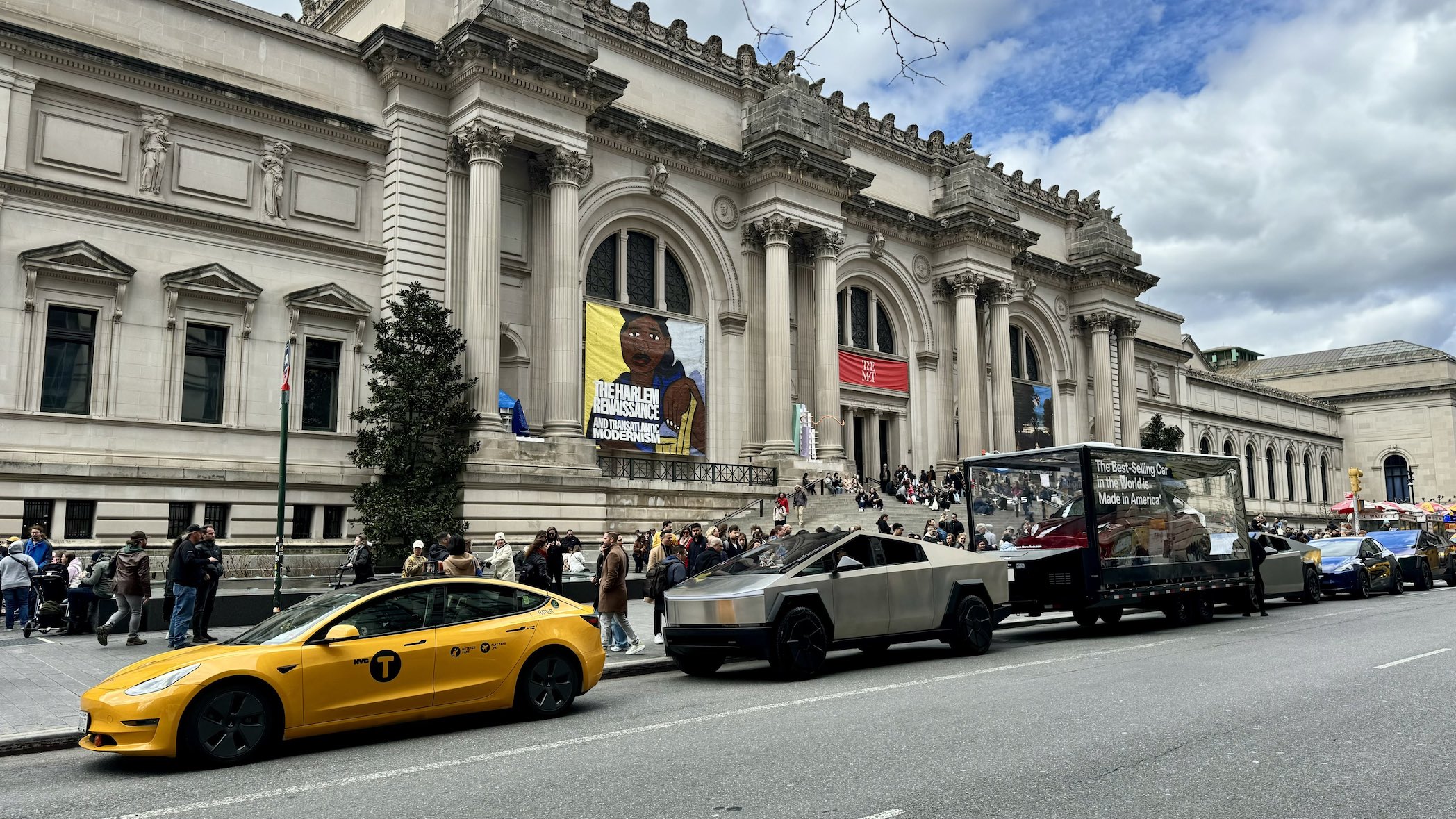

News
Tesla continues its Cybertruck-towed Mobile Gallery in New York City
Tesla continues its so-called “Mobile Gallery” in New York this weekend, in which a Cybertruck has been towing a Model Y encased in glass around the city as a means of advertising.
Last month, a unique advertisement from Tesla was spotted highlighting the Model Y’s status as the best-selling vehicle in the world last year. The advertisement includes a Model Y in a glass case being towed by a Cybertruck, and Tesla has been hauling the display around to different locations in New York City.
Citing preliminary auto data from JATO Dynamics, the glass case reads as follows:
“The Best-Selling Car in the World is Made in America.”
The Cybertruck-towed Model Y ad at Columbus Circle. Credit: Tesla North America | X The Cybertruck-towed Model Y ad at Hayden Planetarium. Credit: Tesla North America | X The Cybertruck-towed Model Y ad at Metropolitan Museum of Art. Credit: Tesla North America | X The Cybertruck-towed Model Y ad at Lincoln Center. Credit: Tesla North America | X



The Tesla North America account posted about the touring display on X on Friday, along with a list of the specific locations the Cybertruck and trailer would be heading to. The route, set to take place from Friday to Sunday, has been hitting popular locations such as the Lincoln Center, the Metropolitan Museum of Art, Times Square, and several other spots.
The account has also been sharing photos and videos to the thread throughout the weekend, and updating its page to keep the public notified of where the display will be headed next. You can see some short video footage from Friday night below, showing multiple additional Cybertrucks surrounding the towing display.
See you again tomorrow, NYC pic.twitter.com/0BM9UpfVwI
— Tesla North America (@tesla_na) April 6, 2024
At the time of writing, the account has said it’s heading to Brooklyn to kick off its final day. You can see Tesla’s full itinerary for the weekend below, as shared by the company on Friday.
Cybertruck-towed Model Y ad in NYC: Friday, April 5
- Columbus Circle
- Lincoln Center
- Planetarium
- Columbia University
- Guggenheim
- The Metropolitan Museum of Art
- Radio City Music Hall
- Rockefeller Center
- NYC Public Library
- Empire State Building
- Bryant Park
- Times Square
Cybertruck-towed Model Y ad in NYC: Saturday, April 6
- Javitz Center
- 11th Ave
Cybertruck-towed Model Y ad in NYC: Sunday, April 7
- Wall Street Charging Bull
- World Trade Center
- Union Square
- Washington Square Park
In recent months, Tesla has increasingly been deploying unique forms of advertising such as this. For example — and despite the fact that it’s not yet on sale in markets outside the U.S. — Tesla has brought the Cybertruck to Germany, China and Japan as a display, along with boosting ads with online retailers, social media and more.
Tesla has also been particularly focused on social media efforts amidst its latest shift toward advertising, with many executives becoming more active on these platforms and interacting directly with product owners, fans, shareholders and others.
Tesla finally leans into its vehicles’ American-made nature by flexing Cybertruck and Model Y
What are your thoughts? Let me know at zach@teslarati.com, find me on X at @zacharyvisconti, or send us tips at tips@teslarati.com.

Elon Musk
Elon Musk and Tesla AI Director share insights after empty driver seat Robotaxi rides
The executives’ unoccupied tests hint at the rapid progress of Tesla’s unsupervised Robotaxi efforts.

Tesla CEO Elon Musk and AI Director Ashok Elluswamy celebrated Christmas Eve by sharing personal experiences with Robotaxi vehicles that had no safety monitor or occupant in the driver’s seat. Musk described the system’s “perfect driving” around Austin, while Elluswamy posted video from the back seat, calling it “an amazing experience.”
The executives’ unoccupied tests hint at the rapid progress of Tesla’s unsupervised Robotaxi efforts.
Elon and Ashok’s firsthand Robotaxi insights
Prior to Musk and the Tesla AI Director’s posts, sightings of unmanned Teslas navigating public roads were widely shared on social media. One such vehicle was spotted in Austin, Texas, which Elon Musk acknowleged by stating that “Testing is underway with no occupants in the car.”
Based on his Christmas Eve post, Musk seemed to have tested an unmanned Tesla himself. “A Tesla with no safety monitor in the car and me sitting in the passenger seat took me all around Austin on Sunday with perfect driving,” Musk wrote in his post.
Elluswamy responded with a 2-minute video showing himself in the rear of an unmanned Tesla. The video featured the vehicle’s empty front seats, as well as its smooth handling through real-world traffic. He captioned his video with the words, “It’s an amazing experience!”
Towards Unsupervised operations
During an xAI Hackathon earlier this month, Elon Musk mentioned that Tesla owed be removing Safety Monitors from its Robotaxis in Austin in just three weeks. “Unsupervised is pretty much solved at this point. So there will be Tesla Robotaxis operating in Austin with no one in them. Not even anyone in the passenger seat in about three weeks,” he said. Musk echoed similar estimates at the 2025 Annual Shareholder Meeting and the Q3 2025 earnings call.
Considering the insights that were posted Musk and Elluswamy, it does appear that Tesla is working hard towards operating its Robotaxis with no safety monitors. This is quite impressive considering that the service was launched just earlier this year.
Elon Musk
Starlink passes 9 million active customers just weeks after hitting 8 million
The milestone highlights the accelerating growth of Starlink, which has now been adding over 20,000 new users per day.

SpaceX’s Starlink satellite internet service has continued its rapid global expansion, surpassing 9 million active customers just weeks after crossing the 8 million mark.
The milestone highlights the accelerating growth of Starlink, which has now been adding over 20,000 new users per day.
9 million customers
In a post on X, SpaceX stated that Starlink now serves over 9 million active users across 155 countries, territories, and markets. The company reached 8 million customers in early November, meaning it added roughly 1 million subscribers in under seven weeks, or about 21,275 new users on average per day.
“Starlink is connecting more than 9M active customers with high-speed internet across 155 countries, territories, and many other markets,” Starlink wrote in a post on its official X account. SpaceX President Gwynne Shotwell also celebrated the milestone on X. “A huge thank you to all of our customers and congrats to the Starlink team for such an incredible product,” she wrote.
That growth rate reflects both rising demand for broadband in underserved regions and Starlink’s expanding satellite constellation, which now includes more than 9,000 low-Earth-orbit satellites designed to deliver high-speed, low-latency internet worldwide.
Starlink’s momentum
Starlink’s momentum has been building up. SpaceX reported 4.6 million Starlink customers in December 2024, followed by 7 million by August 2025, and 8 million customers in November. Independent data also suggests Starlink usage is rising sharply, with Cloudflare reporting that global web traffic from Starlink users more than doubled in 2025, as noted in an Insider report.
Starlink’s momentum is increasingly tied to SpaceX’s broader financial outlook. Elon Musk has said the satellite network is “by far” the company’s largest revenue driver, and reports suggest SpaceX may be positioning itself for an initial public offering as soon as next year, with valuations estimated as high as $1.5 trillion. Musk has also suggested in the past that Starlink could have its own IPO in the future.
News
NVIDIA Director of Robotics: Tesla FSD v14 is the first AI to pass the “Physical Turing Test”
After testing FSD v14, Fan stated that his experience with FSD felt magical at first, but it soon started to feel like a routine.

NVIDIA Director of Robotics Jim Fan has praised Tesla’s Full Self-Driving (Supervised) v14 as the first AI to pass what he described as a “Physical Turing Test.”
After testing FSD v14, Fan stated that his experience with FSD felt magical at first, but it soon started to feel like a routine. And just like smartphones today, removing it now would “actively hurt.”
Jim Fan’s hands-on FSD v14 impressions
Fan, a leading researcher in embodied AI who is currently solving Physical AI at NVIDIA and spearheading the company’s Project GR00T initiative, noted that he actually was late to the Tesla game. He was, however, one of the first to try out FSD v14.
“I was very late to own a Tesla but among the earliest to try out FSD v14. It’s perhaps the first time I experience an AI that passes the Physical Turing Test: after a long day at work, you press a button, lay back, and couldn’t tell if a neural net or a human drove you home,” Fan wrote in a post on X.
Fan added: “Despite knowing exactly how robot learning works, I still find it magical watching the steering wheel turn by itself. First it feels surreal, next it becomes routine. Then, like the smartphone, taking it away actively hurts. This is how humanity gets rewired and glued to god-like technologies.”
The Physical Turing Test
The original Turing Test was conceived by Alan Turing in 1950, and it was aimed at determining if a machine could exhibit behavior that is equivalent to or indistinguishable from a human. By focusing on text-based conversations, the original Turing Test set a high bar for natural language processing and machine learning.
This test has been passed by today’s large language models. However, the capability to converse in a humanlike manner is a completely different challenge from performing real-world problem-solving or physical interactions. Thus, Fan introduced the Physical Turing Test, which challenges AI systems to demonstrate intelligence through physical actions.
Based on Fan’s comments, Tesla has demonstrated these intelligent physical actions with FSD v14. Elon Musk agreed with the NVIDIA executive, stating in a post on X that with FSD v14, “you can sense the sentience maturing.” Musk also praised Tesla AI, calling it the best “real-world AI” today.








